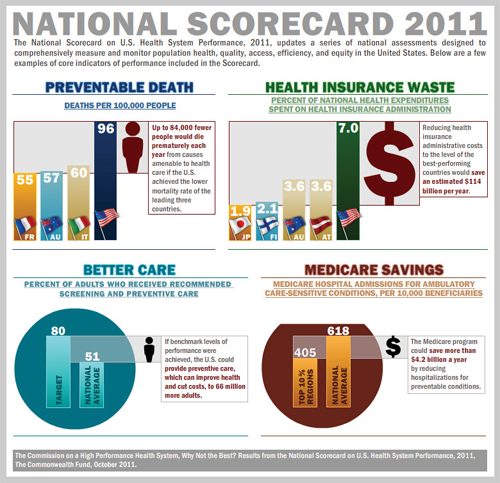
America’s health care system is not getting any better even as it gets more expensive, according to the third comprehensive scorecard issued by the Commonwealth Fund, one of the country’s biggest health care foundations.
After looking at 42 indicators of health care quality, access, cost and other values, the fund gave the U.S. a score of 64 out of 100 on its performance when comparing the nation to the best performing countries, states, regions or health care plans. That was slightly below the 67 the country scored in 2006, the first scorecard the fund issued, and the 65 score the U.S. received in 2008.
“Even though the U.S. is spending more than when we first started issuing the scorecard, we’re not seeing rapid improvement in health care outcomes,” said Cathy Schoen, a senior vice president at the Fund, which is based in New York City.
The scorecard primarily looked at data from 2007 to 2009, before the health care law was adopted last year, and thus is more of a benchmark of where the country was at the end of the last decade than how it is currently doing. Many of its measures have been reported elsewhere or are well known, such as the rising cost of health insurance. Still, the scorecard provides a rare, big-picture assessment of all the ways the country’s health care system is failing or underperforming, as well as a few ways it has gotten better and areas where it has the most room to grow.
The scorecard found improvements in how well adults got their high blood pressure under control, and how well hospitals were doing in preventing surgical complications and treating heart attacks, heart failure and pneumonia. But it also found an increase in hospitalizations of nursing home patients and shortcomings in the ability of sick adults to quickly get to a doctor without going to the emergency room. It also concluded that the U.S. does dismally in terms of how efficiently it uses health care resources, avoids wasteful treatments, limits administrative costs and uses electronic medical records.
“As observed in previous scorecards, the U.S. is not achieving the health outcomes or quality that should be possible with the resources the nation invests,” the report said.






